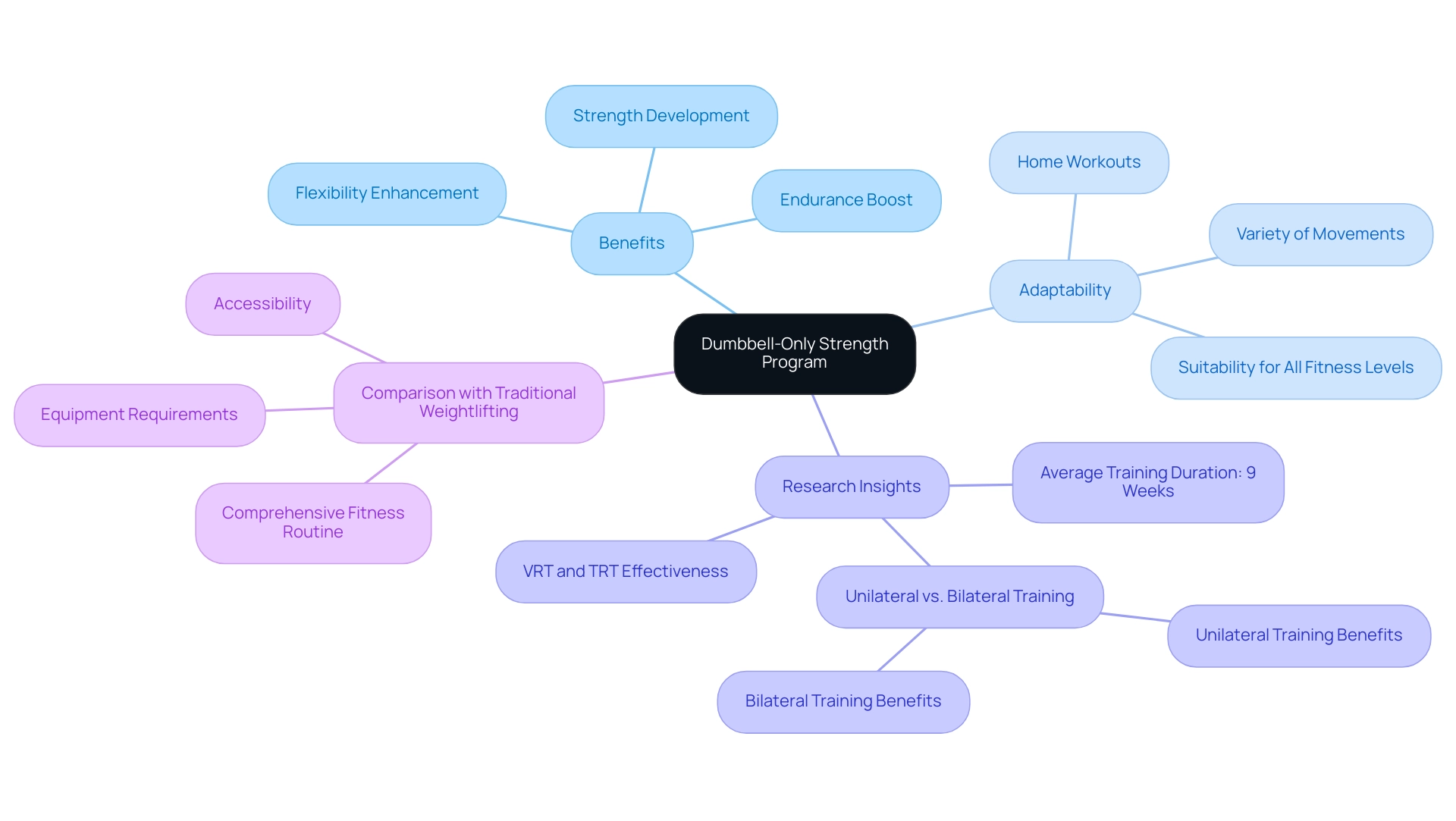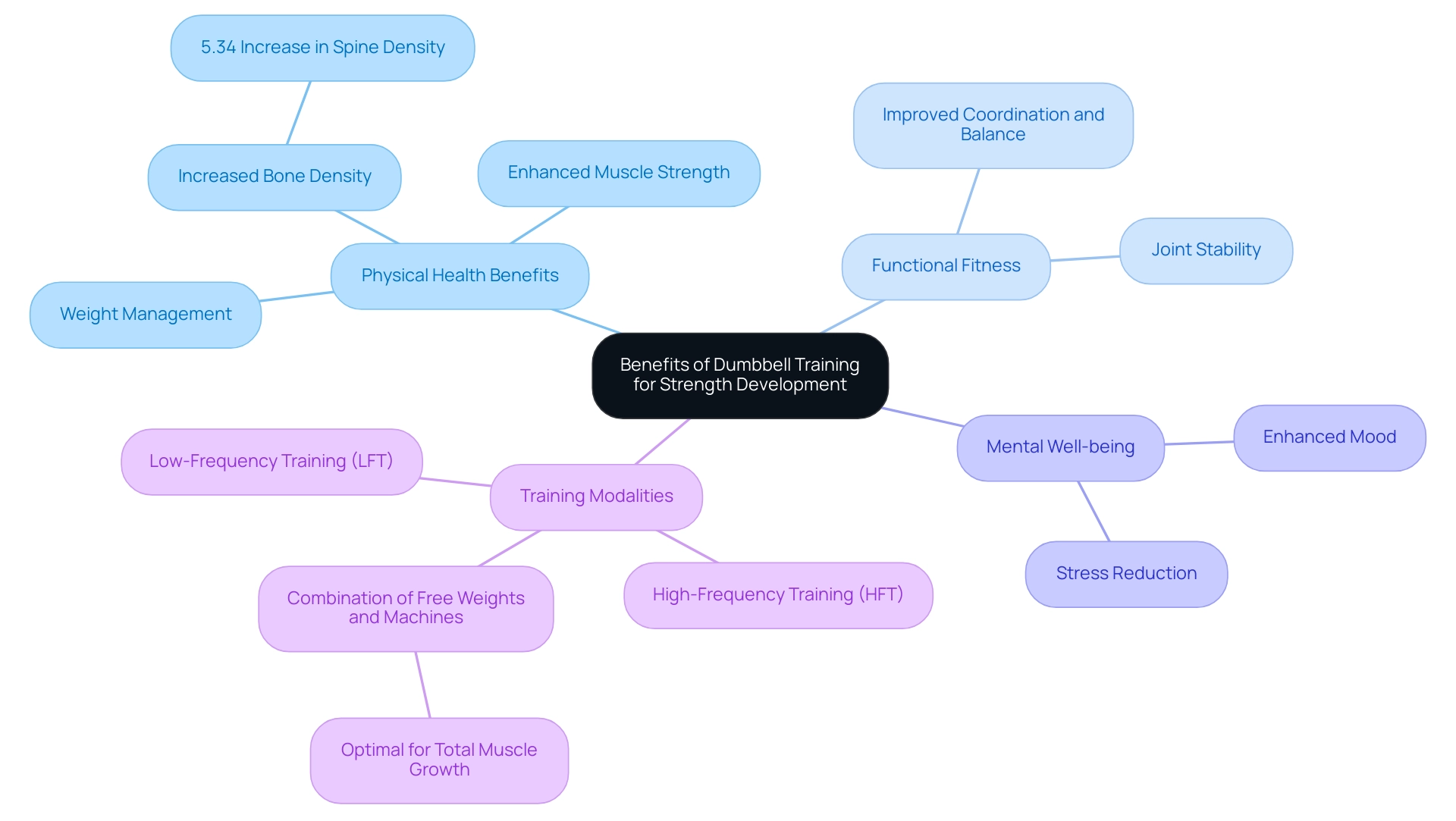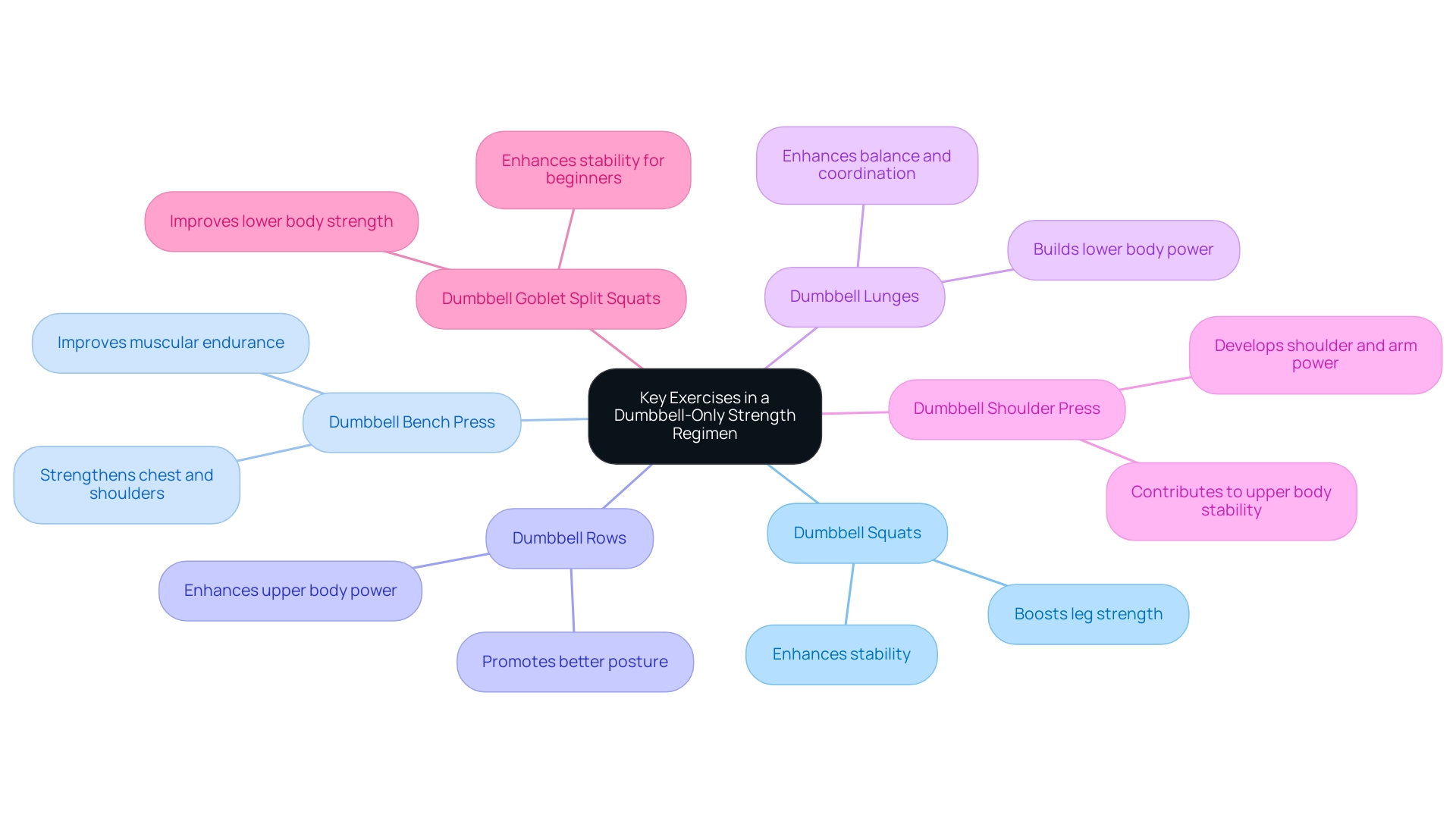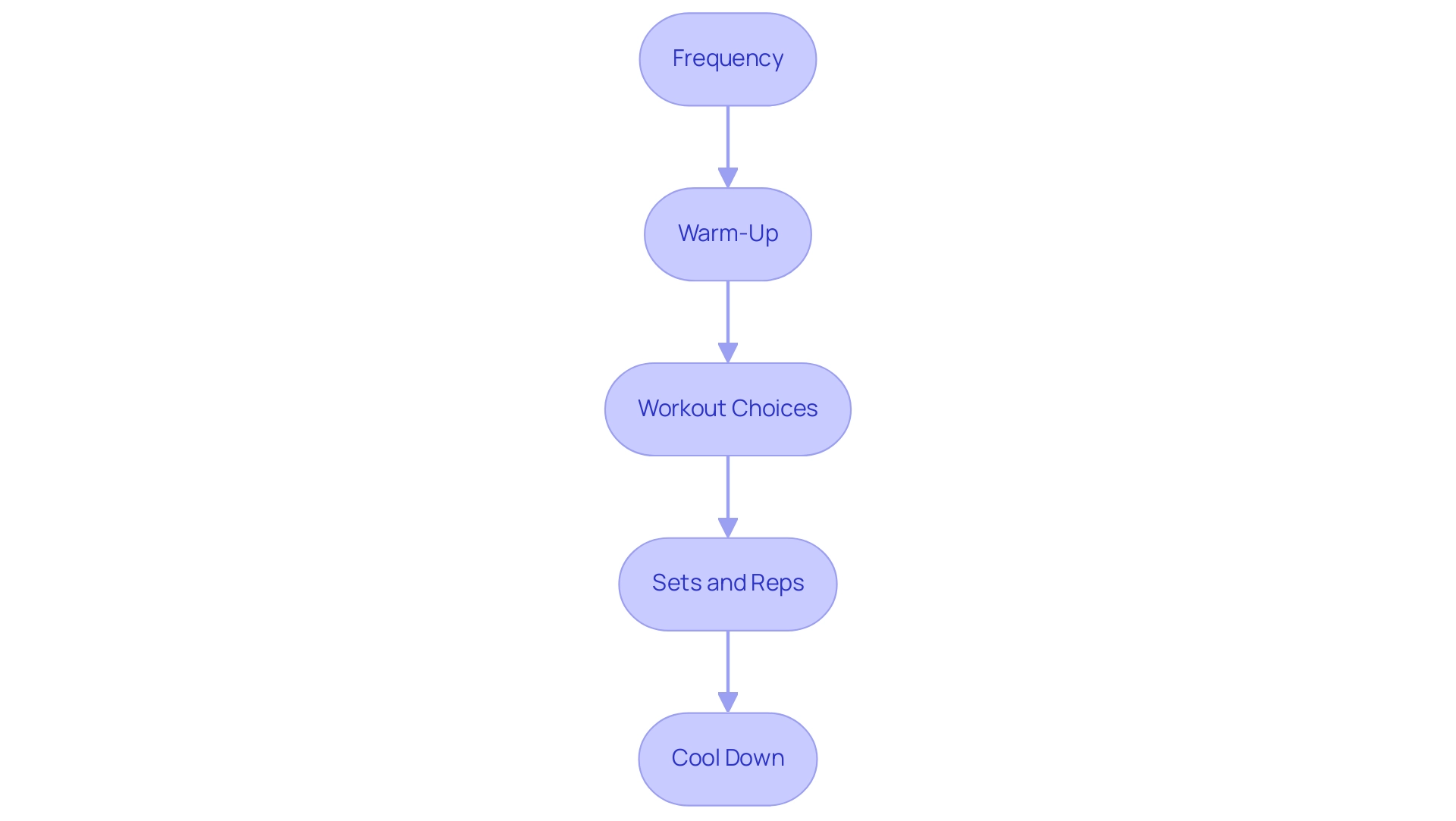Overview
A dumbbell-only strength program is a workout routine that utilizes dumbbells exclusively to enhance strength, endurance, and overall fitness through a variety of exercises tailored to different physical areas. The article supports this by emphasizing the program's adaptability for home workouts, its effectiveness in engaging multiple muscle groups, and its potential benefits for both physical health and mental well-being, making it an appealing option for individuals seeking a comprehensive fitness regimen.
Introduction
In a world where fitness options are abundant yet often overwhelming, a dumbbell-only strength program emerges as a beacon of simplicity and effectiveness. This approach not only caters to those seeking to build muscle and enhance endurance but also offers a versatile solution that can be adapted to various environments—be it the comfort of home or a bustling gym.
With a focus on a select range of exercises, this regimen empowers individuals to take charge of their fitness journey, promoting not just physical strength but also mental resilience.
As the trend toward minimalist training gains momentum, understanding the myriad benefits of dumbbell workouts can inspire HR Benefits Managers to champion well-being initiatives that resonate with their teams, encouraging them to embrace a healthier lifestyle and unlock their full potential.
Defining a Dumbbell-Only Strength Program
A dumbbell only strength program acts as a powerful workout routine that utilizes the simplicity of dumbbells for resistance exercise. By concentrating solely on this equipment, individuals can effectively develop strength, boost endurance, and enhance overall fitness levels through a diverse array of activities targeting different physical areas. Notably, the average intervention duration for free-weight groups spans nine weeks, underscoring the effectiveness of such programs.
This approach stands out from traditional weightlifting, which often necessitates access to a fully equipped gym. In contrast, a dumbbell only strength program is highly adaptable, allowing individuals to engage in workouts at home or any fitness setting. The adaptability of dumbbells enables a wide variety of movements that can be tailored to suit various fitness levels and individual objectives.
Furthermore, recent professional insights indicate that integrating different forms of exercises can enhance growth by inducing diverse regional adaptations, making dumbbells a crucial element of any workout regimen. Asurion Huang observes,
Our findings indicate that VRT and TRT are equally efficient in enhancing maximal physical capability and power in healthy adults.
This strengthens the notion that adopting a balanced method to physical conditioning can produce considerable advantages.
Furthermore, the blend of free weights and machines may further boost overall growth, offering a comprehensive fitness routine.
As we enter 2024, the trend toward a dumbbell only strength program continues to gain popularity, with numerous success stories arising from individuals who have adopted these workouts. The advantages of utilizing dumbbells go beyond mere muscle development; they also enhance flexibility and functional ability, crucial for daily tasks, making them an ideal option for home fitness enthusiasts. Furthermore, understanding diet and physical activity patterns can inform future studies and contribute to promoting exercise among specific populations, such as breast cancer survivors.
Incorporating insights from the case study titled 'Unilateral vs. Bilateral Resistance Exercise' shows that unilateral exercise can greatly enhance unilateral jump performance, while bilateral exercises improve overall power.
By prioritizing a dumbbell only strength program, HR Benefits Managers can inspire their teams to take action toward improved health and well-being.

Benefits of Dumbbell Training for Strength Development
The dumbbell only strength program stands out as a highly effective approach for enhancing power development, offering a range of benefits that cater to various fitness objectives. Research indicates that after participating in resistance training, individuals experience a significant increase in bone mass density, with improvements of up to 5.34% in the spine alone. This is essential not only for physical power and hypertrophy but also for overall bone health.
As Daniel Bubnis, M.S., NASM-CPT, NASE Level II-CSS, emphasizes,
Upper body workouts not only build strength and endurance, they can also build stronger bones and help with weight loss.
Unlike traditional machines that often isolate specific groups, dumbbells engage multiple areas simultaneously, fostering better coordination and balance. This approach not only enhances functional fitness but also contributes to joint stability, making workouts more effective and safer.
Notably, research shows that no significant differences were found between high-frequency methods (HFT) and low-frequency methods (LFT) groups in terms of initial characteristics or outcomes, highlighting that both modalities can be effective. Moreover, the versatility of dumbbells permits a dumbbell only strength program that incorporates progressive overload, which is crucial for continuous gains; users can gradually increase weight and intensity to challenge their muscles consistently. Furthermore, the calorie-burning potential of dumbbell workouts can assist in effective weight management, contributing to healthier lifestyle choices.
Besides physical advantages, resistance exercises have been associated with substantial enhancements in mental well-being. It can reduce stress levels and enhance overall mood, making it a vital component of any wellness initiative. Recent discoveries support the notion that a dumbbell only strength program integrated into fitness routines not only produces physical power but also promotes a comprehensive approach to well-being, which is essential for both individuals and teams.
Furthermore, a mix of free weights and machines might be the best option for enhancing overall strength development, as shown by the evaluation of regional growth variations, which suggests that while total hypertrophy may be comparable between workout methods, regional growth can vary considerably depending on the kind of activity undertaken. This indicates that a comprehensive method to resistance exercise, incorporating both dumbbells and machines, can enhance overall muscle development.

Key Exercises in a Dumbbell-Only Strength Regimen
Integrating essential workouts into a dumbbell only strength program not only supports physical health but also boosts overall team spirit. Here are some essential movements:
- Dumbbell Squats: This foundational exercise targets the lower body, significantly boosting leg strength and stability. As fitness expert Frost puts it,
It shreds your legs into powerful pins by targeting your fast-twitch lower-body muscles, underscoring the importance of this dynamic movement. - Dumbbell Bench Press: An indispensable exercise for the upper body, it effectively strengthens the chest, shoulders, and triceps. This movement is especially advantageous for improving muscular endurance and functional power.
- Dumbbell Rows: This powerful movement focuses on the back muscles, promoting better posture and upper body power. By integrating rows into your regimen, you can counteract the effects of prolonged sitting and improve overall postural alignment.
- Dumbbell Lunges: Renowned for their effectiveness, lunges not only build lower body power but also enhance balance and coordination. This activity is essential for building practical endurance that applies to daily tasks.
- Dumbbell Shoulder Press: A fantastic option for developing shoulder and arm power, this movement contributes to overall upper body stability and resilience.
- Dumbbell Goblet Split Squats: To carry out this movement, hold a dumbbell at your chest and lower your body until the back knee nearly touches the ground. This movement is excellent for improving lower body strength and stability, especially for beginners.
The beauty of these exercises in the dumbbell only strength program lies in their adaptability; each can be modified to suit various fitness levels, making them ideal for both beginners and more advanced users. Furthermore, a recent case study titled "Best Dumbbell Picks for Home Workouts" highlights the importance of having a variety of dumbbells, including adjustable and rubber-encased options, which are essential for a versatile home gym setup. By incorporating a diverse range of movements and considering the need for recovery—given that 40% of men recuperate from high-intensity exercise at 48 hours—you ensure a comprehensive workout that engages all major body groups, setting the stage for improved physical fitness and enhanced team well-being.

Structuring Your Dumbbell-Only Workout Plan
To create an effective dumbbell-only workout plan, it is essential to follow these structured guidelines:
- Frequency: Aim for 2-3 resistance workouts each week. This frequency not only facilitates optimal recovery of tissues but also encourages incremental power improvements. Research shows that every extra day focused on lower body routines can improve weekly gains by 0.10%, highlighting the significance of consistency in your workout plan.
- Warm-Up: Initiate every session with a dynamic warm-up designed to prepare your body for the workout ahead and to reduce the risk of injury. This crucial step enhances performance and sets a positive tone for the session.
- Workout Choices: Choose 5-8 activities that focus on different body areas, ensuring a balanced method to resistance improvement. This variety not only prevents monotony but also promotes overall muscle development.
- Sets and Reps: For strength development, aim for 3-4 sets of 8-12 repetitions for each activity. Adjust the weight accordingly to maintain proper form, which is vital for safety and effectiveness. As James Krieger highlights, even engaging in resistance training for less than one hour per week significantly reduces the risk of metabolic syndrome, emphasizing that even minimal training can provide substantial benefits.
- Cool Down: Conclude each session with a cool-down period that includes stretching movements. This phase is essential for enhancing flexibility and alleviating soreness, supporting recovery and preparation for subsequent workouts.
Moreover, a case study named "Implications for Resistance Exercise Programs for Older Adults" indicates that one set of exercises conducted once weekly may be the minimal effective amount of resistance work required to combat decreases in muscle power due to aging. By adhering to these guidelines, individuals can develop a comprehensive and effective dumbbell-only strength program that fosters strength development and positively contributes to their overall fitness journey.

Avoiding Pitfalls in Dumbbell-Only Training
Maximizing the effectiveness of a dumbbell only strength program requires vigilance in avoiding common pitfalls. Here are critical areas to focus on for a successful and safe training experience:
- Proper Form: Always prioritize technique over lifting heavier weights. Neglecting form can lead to injuries, significantly affecting overall success in exercise. According to recent findings, the total 6RM loads in the Barbell Bench Press (BBP) was 88.5 ± 16.0kg, while in the Dumbbell Fly (DF) it was 40.5 ± 7.7kg (p < 0.001, ES = 3.82). Poor execution can result in the Latissimus Dorsi taking undue strain during exercises like the rear lateral raise, undermining the intended engagement of the targeted area. As Atle Hole Saeterbakken noted, "The findings cannot be generalized to other populations," highlighting the need for individualized attention to form. Feedback on form is crucial to ensure that the prime movers are activated effectively.
- Neglecting Recovery: Allowing adequate rest between workouts is essential. Overtraining can lead to burnout and diminish motivation, making recovery a non-negotiable aspect of any training regimen.
- Inconsistent Workouts: Establishing a regular workout schedule fosters progress and keeps motivation high. Consistency is key to achieving and maintaining fitness goals.
- Ignoring Warm-Up and Cool Down: Skipping these vital components can elevate injury risks and slow recovery. A proper warm-up prepares the body for the workout ahead, while cooling down aids in recovery and helps to prevent stiffness.
- Limited Exercise Variety: Incorporating a wide range of movements is essential to engage all muscle groups and prevent imbalances. This diversity not only enhances strength but also keeps workouts interesting and motivating.
By recognizing these pitfalls and taking proactive measures to address them, individuals can cultivate a safe, effective, and motivating dumbbell only strength program, ultimately reaping the rewards of their efforts. Additionally, it is crucial to execute movements correctly; when elbows travel under the shoulders during rear lateral raises, the Latissimus Dorsi takes the majority of the load, which forfeits the purpose of the exercise. Correct execution is necessary to effectively target the rear delts, and trainees often require feedback to ensure proper form.

Conclusion
Embracing a dumbbell-only strength program offers a straightforward and effective pathway to achieving fitness goals. This approach not only enhances muscle strength and endurance but also provides the versatility needed for workouts at home or in a gym setting. With a focus on key exercises that engage multiple muscle groups, individuals can cultivate functional strength, improve coordination, and promote overall well-being.
The benefits extend beyond physical health; incorporating dumbbell training into wellness initiatives can significantly boost mental health and team morale. The structured guidelines for workout frequency, warm-ups, exercise selection, and recovery ensure that everyone can participate safely and effectively, regardless of their fitness level. Furthermore, avoiding common pitfalls, such as neglecting proper form and recovery, reinforces the importance of a mindful approach to training.
Ultimately, the shift toward a dumbbell-only regimen not only empowers individuals to take charge of their fitness journeys but also fosters a culture of health and resilience within teams. By championing this simple yet powerful training method, HR Benefits Managers can inspire their teams to prioritize their well-being, unlock their full potential, and embrace a healthier lifestyle. The time to act is now; a commitment to strength training can lead to lasting benefits for both individuals and organizations alike.
Frequently Asked Questions
What is a dumbbell only strength program?
A dumbbell only strength program is a workout routine that utilizes dumbbells for resistance exercises, allowing individuals to develop strength, boost endurance, and enhance overall fitness levels through a variety of movements targeting different physical areas.
How long do these programs typically last?
The average intervention duration for free-weight groups in dumbbell only strength programs spans approximately nine weeks, highlighting their effectiveness.
How does a dumbbell only strength program differ from traditional weightlifting?
Unlike traditional weightlifting, which often requires access to a fully equipped gym, a dumbbell only strength program is highly adaptable and can be performed at home or in any fitness setting.
What are the benefits of using dumbbells in strength training?
Dumbbells engage multiple muscle groups simultaneously, improving coordination, balance, functional fitness, joint stability, and flexibility. They also enhance muscle development and can aid in weight management through calorie burning.
What insights do recent studies provide about the effectiveness of dumbbell workouts?
Research indicates that both high-frequency and low-frequency training methods can be effective, and integrating various forms of exercises can enhance growth by inducing diverse regional adaptations.
Can dumbbell workouts improve mental well-being?
Yes, resistance exercises, including dumbbell workouts, have been associated with significant enhancements in mental well-being, such as reducing stress levels and improving overall mood.
How does a dumbbell only strength program support bone health?
Participating in resistance training, including dumbbell workouts, has been shown to increase bone mass density, which is crucial for physical power, hypertrophy, and overall bone health.
Is there a recommended approach to combining different types of resistance training?
A comprehensive approach that combines both dumbbells and machines may enhance overall strength development, as different methods can yield varying regional growth in muscles.
Who can benefit from a dumbbell only strength program?
Individuals looking to improve their health and well-being, including fitness enthusiasts and those participating in wellness initiatives, can benefit from a dumbbell only strength program.

